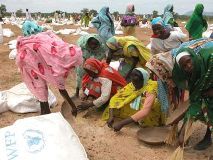WFP halving Darfur rations on funds shortage
April 28, 2006 (GENEVA) — The U.N. food agency said Friday it is halving rations to more than 3 million people in Sudan’s embattled Darfur region because of a shortage of funds.

|
|
Teams of women carefully brush up grains of cereals that spilled from bags air dropped by the World Food Programme, August 15, 2004. |
The World Food Program will cut rations from 2,100 calories a person to 1,050, spokeswoman Christiane Berthiaume said.
“WFP has to cut the food rations to millions of vulnerable people in Sudan,” Berthiaume told reporters. “It’s scandalous that people don’t have enough to eat.”
Donor governments have given WFP only $238 million of the $746 million it appealed for this year for the whole of Sudan, Berthiaume said.
(ST/AP)
Adding insult to injury? Sharp ration cuts leave Darfur on a diet
KHARTOUM/GENEVA – Despite the horrific suffering of millions of vulnerable people across Sudan, the United Nations World Food Programme (WFP) said today that a severe shortage of funds has forced it to make drastic cuts in food rations from May.
By reducing the daily rations to as little as 1,050 kilocalories — half the minimum daily requirement of 2,100 kilocalories per person — WFP says its limited food stocks will last longer during the ‘hunger season,’ the annual period from July to September when needs are the greatest before the next harvest.
“This is one of the hardest decisions I have ever made. Haven’t the people of Darfur suffered enough? Aren’t we adding insult to injury? It’s so hard to understand this funding shortfall because last year official development assistance climbed all the way to US$107 billion — double what it was just a few years ago. Donors are being incredibly generous — but they are not putting victims of humanitarian crises like Darfur first on their list,” said James Morris, WFP Executive Director.
“Food must come first — we cannot put families who have lost their homes and loved ones to violence on a 1000 calorie a day diet. But we have been pushed into this last resort of ration cuts in Sudan so we can provide the needy with at least some food during the lean season. This is a measure we should simply never have to take. Our donors were really supportive in 2005 — they cannot be less so in 2006,” Morris added.
Despite repeated appeals to donors, WFP has received just US$238 million or 32 percent of the US$746 million required to provide food assistance to 6.1 million people in Sudan this year in Darfur, the South, Central, East and the Three Areas (formerly the Transitional Areas of Abyei, South Kordofan and Blue Nile). WFP is particularly concerned about the effect of reduced rations in Darfur, where rampant insecurity continues to cause enormous suffering.
People in Darfur will receive half the usual amount (in weight) of cereals, blended fortified food and oil, and one quarter of the usual pulses, sugar and salt. The energy content of the food ration will fall from the minimum daily requirement of 2,100 kilocalories per person per day to 1,050 kilocalories per person.
Similar cuts will be made in the East, where WFP assists Eritrean refugees and displaced families.
“What is deeply disturbing is that these funding shortages threaten the gains made last year by humanitarian agencies in Darfur, where malnutrition levels went down by half. We were making great progress. A nutrition survey in September 2005 showed that four families in five were still dependent on food aid. We’re very concerned now because UNICEF is reporting increased malnutrition rates already this year,” Morris said.
In March, WFP announced a first reduction in pulses, sugar and salt rations by half in weight terms for up to 3.5 million people across Sudan because of the slow donor response. Toward the end of February, WFP had just four percent of the contributions it needs for Sudan in 2006. While some funds have arrived since then, they were too little and too late to avert the new round of cuts.
It has also been impossible for WFP to procure and pre-position enough food for full rations for hundreds of thousands of people in areas that will be inaccessible by road during the June-September rainy season. It can take four months or more for a pledge to appear as food on the ground in Sudan.
The South, recovering from two decades of civil war, will not be affected by the cuts because most people receive 50-75 percent of a full ration in general food distributions from WFP. Distributions in the South take into account the fact that people are able to grow at least part of the food they need.
Returnees, internally displaced people and refugees receive full WFP rations in the South – as do school children and malnourished children and mothers through supplementary and institutional feeding. The Three Areas will be affected by the cuts but to a lesser extent than Darfur and the East.
Hundreds of thousands of returnees and vulnerable host communities in the South and Three Areas need food aid to help get them through the first difficult months until they can become self-sufficient.
“Throughout this critical year for Sudan, when peace must be allowed to take hold, WFP urgently needs donors to come forward so that we can guarantee food aid to the millions of Sudanese who so desperately need our help,” said Morris.
Donors to WFP’s 2006 Sudan emergency operation are: the United States (US$188 million); United Nations Common Humanitarian Fund (US$16.6 million); Libya (US$4.5 million); Canada (US$3.9 million); Norway (US$1.8 million); Ireland (US$1.2 million); Italy (US$1.2 million); Switzerland (US$757,600); Belgium (US$604,600); Private (US$20,000).
For more information please contact (email address: [email protected]):
